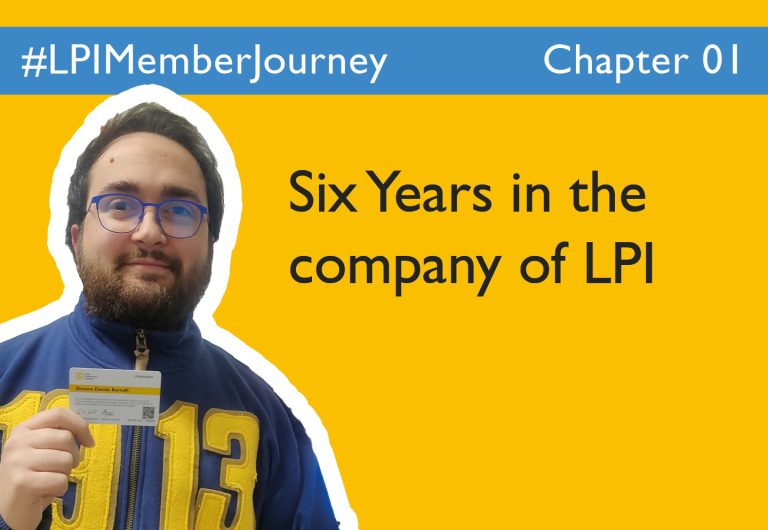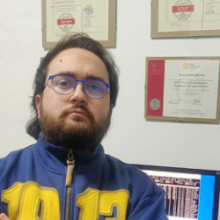Simone “Simo” Bertulli: Six years in the company of LPI

A Membership Journey, Chapter 01
Linux Professional Institute (LPI) has recently launched its Membership Program. The Program gives you the opportunity to get more involved with the LPI mission and activities. Members enjoy substantial benefits, such as discounts on exams, services, and hardware, as well as a direct involvement in the governance of the organization by electing the LPI board.
Simone “Simo” Bertulli, an LPI evangelist from Italy, and a LPIC-3 certified professional, enthusiastically joined the community from the very beginning. Here Simo shares his journey as a first-hour LPI member.
Let’s now give the floor to Simo, and please remember to revisit the LPI blog for the next issues of the #LPIMemberJourney series!
The beginnings
A passion for computer science always ran in my blood. But it was in 2011, when I was 22 years old, that I approached the Linux world more consistently and curiously, through the fairly complex topic of clusters.
Yes, sure… I started the very very first step by installing an Ubuntu 8.04 LTS distribution on an old desktop computer, but I wasn’t aware yet of the real potential of the Linux kernel. My attention was more on the scientific environment, especially in the field of physics. In particular, the research of the Higgs Boson that took place at CERN (in the LHC powered by Linux) and the SETI@home project piqued my curiosity. While studying the High Performance Cluster (HPC) meshes used in scientific fields, I discovered a reference to Linux systems and pursued it to learn more about open source operating systems. CentOS and the Scientific Linux distribution derived from it were the first systems that began my technical journey into the open source world.
I still remember very fondly the moment I installed Scientific Linux on my servers with the old Xeon platform and SCSI disks, to start experimenting!
The Raspberry revolution
Soon I shifted my attention to what was at the time a new and revolutionary project: the Raspberry Pi board which, for the first time, launched a never-before-seen cost/performance model. Raspberry Pi allowed me to continue in a greener way and with a completely new overall design for my Linux experience. On that board, which was based on the ARM CPU architecture, I created my first file server using OpenMediaVault (a Debian-based OS dedicated for NAS), media servers, and an Access Point (AP).
Later, I discovered that Linux was in perfect symbiosis with the networking world, and I decided to test the DD-WRT and Open-WRT projects at first in the laboratory network… eventually using them by default as the first choice.
Joining the Linux community
In 2012 I took my first professional steps with Linux in a nonprofit association that dealt with trashware.
A few years later, in early 2016, with some other colleagues, I co founded the “Industria Italiana del Software Libero” community. I held the role of Chief Networking Officer and, for one and half years, dealt with the creation and editing of documentation on Linux distributions and open software.
It was at that time that I first heard about LPI. I quickly understood that my career and my personal growth could benefit from a certified and structured path of “knowing and knowing how to do”, exactly what the LPI framework was all about: it was certification time!
Stepping into LPI: LPIC-1
In June 2016 I obtained the CompTIA Linux+ certification, which was bundled with the LPIC-1 and SuSE CLA. To prepare for the two exams I needed to achieve the certification, I used the manuals suggested in the LPI marketplace. I thus started my self-taught process, creating a small virtual lab on a common workstation and dedicating to it at least 3 to 4 hours a day for about two months.
It was only a few months later that the first job offers in the field of cybersecurity started to come in: I am from Pavia, Lombardy, northern Italy, and I was looking for a position in the Milan area.
LPIC-2, LPIC-3
In September 2017, after about 3 months of study, I obtained the LPIC-2 certification. LPIC-2 covers a fair amount of topics, with really consistent objectives, The certification allows you to get to the bottom of topics that are very useful in the professional context, such as systems security and networking at a more advanced level: firewall, VPN issues, etc.
In January 2019, finally, I obtained the LPIC-3 certification on virtualization and high availability. It’s useful in business environments employing cluster-based technologies that require dedicated balancing systems, workload distribution, and reliability.
My “recipe” for succeeding in the LPI exams
Preparation for specialist exams, such as the ones in the LPI multi-level path, requires at least three or four years of experience in a medium-to-large business, so that you have the opportunity to see the “enterprise” class scenarios in the exams directly applied in a production environment.
After the achievement of the LPIC-2 certification, the doors of enterprise-class job organizations opened. Today I still work in a Security Operation Center of one of the greatest companies in Italy and Europe in the oil and gas sector. Here I can fully exploit what I acquired from this training path, continuing to deepen my technical skills by opening professional horizons.
In this workplace I can put many of my acquired skills into practice. For example, we could design and create a cybersecurity laboratory in a virtual environment, integrating multiple tools and operating systems that can cover all possible needs. These technologies include REMnux to analyze malware, reverse engineering activities, and compromised files; Kali Linux to perform internal red team tests; CAINE for digital forensics activities; and more.
During deployment, my knowledge of virtualization, load balancing, and fault-tolerance is fundamental to better manage the resources for application services. It lets me understand the workload distribution “on-demand” and on all operating layers, as well as the issues of physical and logical redundancy.
Although my professional career is oriented toward the world of security, I believe it is necessary first to create a strong background about systems administration and networking on which to build those types of skills.
Looking ahead and beyond…
My ideal approach to a career is continuous learning, so I am now preparing for the Linux LPIC-3 Security exam, an important milestone for those who work in the cybersecurity environment. This exam deals with commonly used topics in a SOC such as certificate and PKI management, authentication, encryption, access control methods, network security, and hardening.
Already, while taking the first steps towards the most coveted goal of specialization, one of the many valuable features of LPI that I was able to appreciate was undoubtedly the possibility of renewing previous certifications if I had passed a higher level exam.
This news, which on the one hand further revived the motivation to achieve my goals, aroused a perplexity that would have eventually become clear to many certification holders. I feared that this logic of “cascading renewals” could over time become the chief (or only) reason for trying to become certified at a higher level. Once you reached the highest level of certification, this logic meant that you would lose interest in LPI and stop learning or staying involved. So what to do?
Of course, the certifications last five years (!). I consider this a great plus that has excellent repercussions in the professional field. However … one of my biggest perplexities remained, that of supporting a continuous effort in continuous study to keep the the certifications acquired over time running.
All in all, 2020 has not only brought bad news: something new arrived … LPI Membership!
To my great happiness, LPI hereby introduces a system that allows me to keep my certifications active by accumulating credits that can be obtained thanks to the relevant professional activities, dissemination events, participation in communities, and so on.
And that’s not all: indeed, it seems we are only at the beginning!
Some other very interesting points give this initiative an innovative and dynamic character, as it goes far beyond the renewal of a certification. It places the LPI people in the foreground.
Despite the global pandemic and the economic crisis, the demand for professionals in open source is constantly growing. In my opinion, certification is the best choice for professional growth, not being tied to any specific commercial vendor and focusing only on the real value of training and skills.
Obtaining LPI membership is very simple: you must be at least LPIC-1 certified, accept the code of ethics and the membership agreement, and pay the membership fees; for more information here is a descriptive link: https://www.lpi.org/it/member/program. After that you have to wait for the approval of the request … that’s it!
You have a choice whether to join for 1 or 3 years. I have chosen the longest lasting solution, in order to be able to count on a cycle of training and continuous renewal that remains stable over time, with the all-round benefits.
Along with the membership, you receive a personalized kit with a card and stickers, based on the level of training achieved: take a look (Figure 1)!
Figure 1. Welcome kit sent by LPI to new members

I believe that LPI is already on the path of becoming an unmatched reference for certifications both in the GNU/Linux world and in that of open source software. With the Membership initiative LPI is laying the foundations to create a solid framework for all the IT professionals of every technical field.
I was really interested in actually being part of LPI: the even more recent launch of the “Share your voice” initiative rang a bell and triggered the idea that turned into this very post—even better: a post series! I was sure I had a story to tell, and a story that could inspire more professionals who are starting or nurturing their IT career path using the effectiveness of the LPI certifications. I thought that giving a from within glimpse to the Membership Program would be an interesting story to tell as well.
Writing this posting was an experience that involved the editorial part too, with many aspects such as the drafting, the whole storytelling, and the related interactions with all the links in the LPI chain… : So here we are: stay tuned for getting to know more extensively and deeply about what it means to be a proud member of the LPI huddle!
Note from LPI: Although everyone’s journey is unique, consider sharing yours and help inspire …
